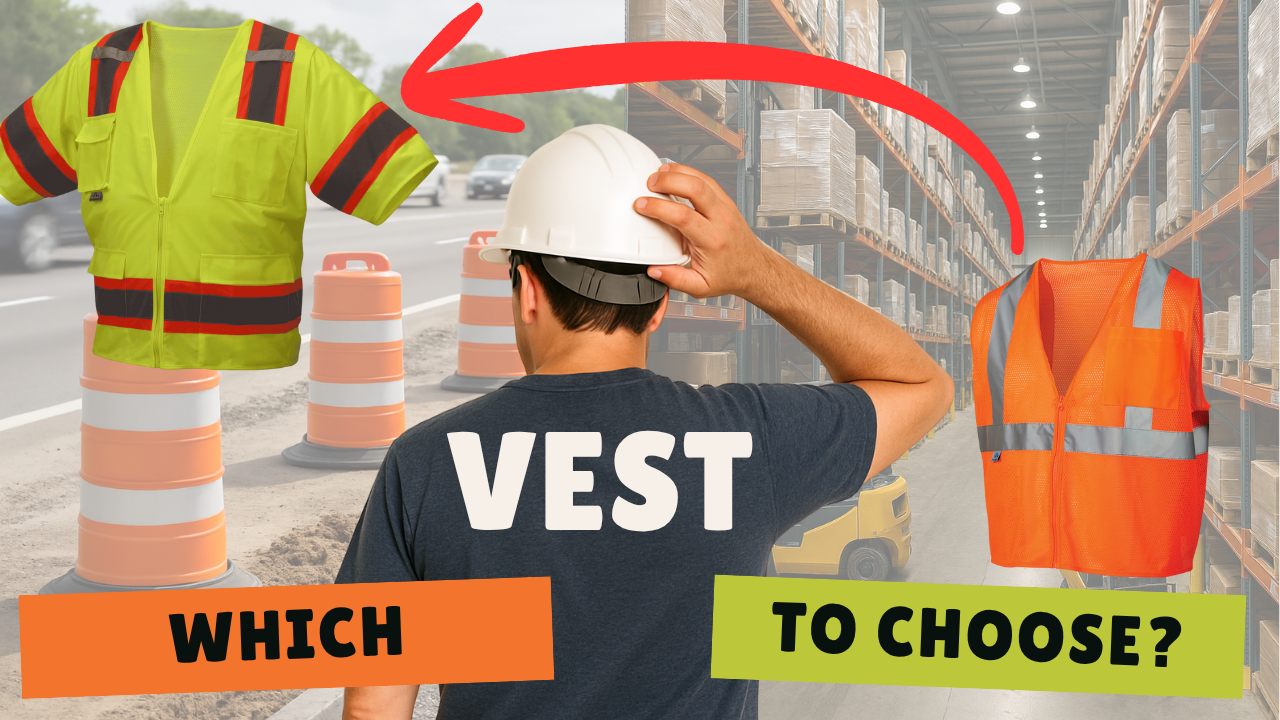
Which Safety Vest is Right for You? A Complete Guide to ANSI Classes and Types
Workplace safety starts with visibility. Wearing the right ANSI-compliant vest ensures you're meeting regulations and minimizing risk in high-traffic or low-light conditions. Whether you're on a construction site, managing traffic, or responding to emergencies, wearing the correct ANSI-rated safety vest can mean the difference between being seen or being at risk.
In this guide, we’ll break down the different types and classes of safety vests, what ANSI 107-2020 means, and how to choose the right vest for your job site.
Understanding ANSI 107-2020: The Safety Vest Standard
ANSI/ISEA 107-2020 is the American National Standard that governs the design and performance of high-visibility safety apparel. It defines requirements for:
-
Reflective tape placement
-
Background fabric color
-
Minimum visibility
-
Design standards for safety vests and other high-visibility gear
There are two key categories under this standard: Types (based on job environments) and Classes (based on visibility needs).
The 3 Types of Safety Vests
Type O – Off-Road Safety Vests
Type O vests are designed for workers who operate in environments completely separated from road traffic. This includes settings such as warehouses, airport operations, or staffing at events. These vests provide the lowest level of visibility and are only required to meet the minimum standards of Class 1 visibility. Since they are not exposed to moving vehicles, the focus is on providing basic visibility within a controlled setting rather than high-risk traffic zones.
Type R – Roadway Safety Vests
Type R vests are intended for workers who are exposed to roadway traffic. These are the most commonly used vests on job sites where vehicles are present, especially in industries like construction, road maintenance, and surveying. Because of the traffic hazards, Type R vests must comply with Class 2 or Class 3 ANSI standards, offering significantly greater visibility through higher amounts of reflective material and background fabric.
Type P – Public Safety Vests
Specifically designed for first responders and public safety personnel, Type P vests serve roles such as police officers, firefighters, and emergency medical services. These vests often come with specialized features tailored to emergency situations, such as tear-away functionality for quick removal, additional storage pockets, and color-coding for fast identification. While visibility is important, functionality and adaptability are key to their design.
The 3 Classes of Safety Vests
Class 1 Safety Vests
Class 1 safety vests are the most basic level of high-visibility apparel. They are suitable for jobs in low-risk environments where traffic is minimal and moves at 25 mph or less. Typical users include warehouse staff, parking lot attendants, or delivery drivers. These vests require at least 217 square inches of high-visibility background fabric and 155 square inches of reflective tape, offering sufficient visibility in controlled, low-speed settings.
Class 2 Safety Vests
For environments with moderate risk—such as roadways with traffic under 50 mph—Class 2 safety vests provide enhanced visibility. These vests have a larger amount of high-visibility material compared to Class 1 and include at least 2-inch-wide reflective tape for better detection. They are common on construction sites, utility crews, and survey teams. A good rule of thumb: if the vest has no sleeves but a high amount of reflective tape, it’s likely Class 2.
Class 3 Safety Vests
Class 3 vests offer the highest level of visibility and are required in the most hazardous environments, such as highways or areas with high-speed traffic exceeding 50 mph. These vests include sleeves covered in reflective material and often appear more like jackets or full-coverage gear. They are essential for night work or low-light conditions and are frequently worn by highway maintenance teams, tow truck drivers, and emergency responders. If the vest has sleeves and extensive reflective coverage, it's almost certainly Class 3.
How to Choose the Right Safety Vest
Choosing the right safety vest depends on:
-
Job site environment
-
Traffic exposure and speed
-
Lighting conditions
-
Compliance with local safety regulations
Quick rule of thumb:
-
No traffic → Type O
-
Road traffic → Type R
-
Emergency response → Type P
Visibility needs:
-
Minimal risk → Class 1
-
Moderate risk → Class 2
-
High risk → Class 3
Always check the label for ANSI certification before issuing a vest to your crew.
Why the Right Vest Matters
Wearing the wrong type or class of safety vest isn’t just a minor oversight—it can have serious consequences. Improper PPE can result in non-compliance penalties from regulatory bodies and, more importantly, can dramatically increase the risk of injury or death due to reduced visibility. Workers in hazardous environments depend on their gear to stay safe, and choosing the correct vest is a critical part of that equation.
When your team wears the right vest, they’re more than just visible—they’re protected. It’s not just about checking off a box for safety regulations; it’s about ensuring everyone goes home safely at the end of the day.
Where to Buy ANSI-Compliant Safety Vests
Looking for high-quality, ANSI-certified safety vests? Visit inlandempiresafety.com. We supply reliable, professional-grade PPE to thousands of companies nationwide—so you can protect your workforce and meet OSHA standards.
